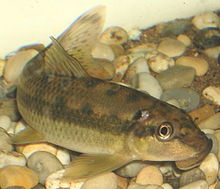| Gyrinocheilus aymonieri | |
|---|---|

| |
| Gyrinocheilus aymonieri | |
| Scientific classification | |
| Domain: | Eukaryota |
| Kingdom: | Animalia |
| Phylum: | Chordata |
| Class: | Actinopterygii |
| Order: | Cypriniformes |
| Family: | Gyrinocheilidae |
| Genus: | Gyrinocheilus |
| Species: | G. aymonieri
|
| Binomial name | |
| Gyrinocheilus aymonieri (Tirant, 1883)
| |
| Synonyms | |
| |
Gyrinocheilus aymonieri is a freshwater fish native to large parts of Southeast Asia.[2][3][4] It is of interest as a local food source and for the aquarium trade.[1][3] Its common names include honey sucker, sucking loach and Chinese algae eater.[3]
G. aymonieri is found in the Chao Phraya basin, northern Malay Peninsula, Mekong basin (in Cambodia, Yunnan province in China, Laos, Thailand, and Vietnam[1]), Mae Klong basin and the Xe Bang Fai River.[2] It is most often seen in large rivers, occasionally entering flooded fields.[5] The fish spends most of its time on flat surfaces, such as rocks, in flowing water, using its unusually formed inferior mouth to attach itself to rocks in stronger flows.[6]
The fish are sold in local markets as a food source and small fish are used in preparation of prahok.[1]
- ^ a b c d Vidthayanon, C. (2012). "Gyrinocheilus aymonieri". IUCN Red List of Threatened Species. 2012: e.T180997A1686747. doi:10.2305/IUCN.UK.2012-1.RLTS.T180997A1686747.en. Retrieved 13 November 2021.
- ^ a b Kottelat, Maurice (July 1998). "Fishes of the Nam Theun and Xe Bangfai basins, Laos, with diagnoses of 22 new species (Teleostei: Cyprinidae, Balitoridae, Cobitidae, Coiidae and Odontobutidae)". Ichthyological Exploration of Freshwaters. 9 (1): 1–128.
- ^ a b c Froese, Rainer; Pauly, Daniel (eds.). "Gyrinocheilus aymonieri". FishBase. August 2015 version.
- ^ Eschmeyer, William N.; Fricke, Ron & van der Laan, Richard (eds.). "Species related to Gyrinocheilus aymonieri". Catalog of Fishes. California Academy of Sciences. Retrieved 13 November 2015.
- ^ Taki, Y. (1978). "An analytical study of the fish fauna of the Mekong basin as a biological production system in nature". Research Institute of Evolutionary Biology Special Publications. 1: 77.
- ^ Rainboth, Walter J. (1996). Fishes of the Cambodian Mekong. Rome: FAO (Food and agriculture organization of the United Nations). p. 265. ISBN 92-5-103743-4. Archived from the original on 2018-08-31. Retrieved 2011-10-24.
